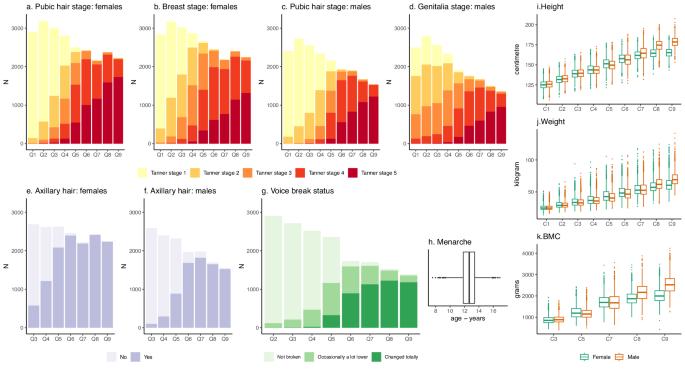Evaluation and comparison of nine growth and development-based measures of pubertal timing
IF 5.4
Q1 MEDICINE, RESEARCH & EXPERIMENTAL
引用次数: 0
Abstract
Pubertal timing is heritable, varies between individuals, and has implications for life-course health. There are many different indicators of pubertal timing, and how they relate to each other is unclear. Our aim was to quantitatively compare nine indicators of pubertal timing. We used data from questionnaires and height, weight, and bone measurements from ages 7–17 y in a population-based cohort of 4267 females and 4251 males to compare nine growth and development-based indicators of pubertal timing. We summarise age of each indicator, their phenotypic and genetic correlations, and how they relate to established genetic risk score (GRS) for puberty timing, and phenotypic childhood body composition measures. We show that pubic hair in males (mean: 12.6 y) and breasts in females (11.5 y) are early indicators of puberty, and voice breaking (14.2 y) and menarche (12.7 y) are late indicators however, there is substantial variation between individuals in pubertal age. All indicators show evidence of positive phenotypic intercorrelations (e.g., r = 0.49: male genitalia and pubic hair ages), and positive genetic intercorrelations. An age at menarche GRS positively associates with all other pubertal age indicators (e.g., difference in female age at peak height velocity per SD higher GRS: 0.24 y, 95%CI: 0.21 to 0.26), as does an age at voice breaking GRS (e.g., difference in age at male axillary hair: 0.11 y, 0.07 to 0.15). Higher childhood fat mass and lean mass associated with earlier puberty timing. Our findings provide insights into the measurements of the timing of pubertal growth and development and illustrate value of various pubertal timing indicators in life-course research. Age of puberty varies between individuals and can affect a person’s future health. We obtained information from 8500 British children as they progressed through puberty. We compared nine measures of pubertal timing. We found that the appearance of pubic hair in boys and breasts in girls are early indicators of puberty, and that voice change and onset of menstruation are late indicators. However, there was also substantial variability between individuals in age of puberty. All puberty measures were correlated with each other and related to an individual’s adult body mass index, as well as to their childhood muscle and fat mass. Our findings are useful information for health care workers and researchers who are interested in assessing and studying puberty. Elhakeem et al. evaluate and compare nine measures of pubertal timing using longitudinal assessments from a prospective British birth cohort study. The findings suggest all are consistent measures of pubertal timing and measure the same biological process.

对九种基于生长发育的青春期时间测量方法进行评估和比较。
背景:青春期时间具有遗传性,因人而异,对一生的健康都有影响。有许多不同的青春期时间指标,它们之间的关系尚不清楚。我们的目的是对青春期时间的九个指标进行定量比较:方法:我们通过对 4267 名女性和 4251 名男性在 7-17 岁期间的问卷调查以及身高、体重和骨骼测量数据,比较了九个基于生长发育的青春期时间指标。我们总结了每个指标的年龄、其表型和遗传相关性,以及它们与已确定的青春期时间遗传风险评分(GRS)和表型儿童身体成分测量的关系:结果:我们发现,男性的阴毛(平均 12.6 岁)和女性的乳房(11.5 岁)是青春期的早期指标,而破音(14.2 岁)和初潮(12.7 岁)是青春期的晚期指标,但不同个体的青春期年龄存在很大差异。所有指标都显示出表型间的正相关(例如,r = 0.49:男性生殖器和阴毛年龄)和遗传间的正相关。月经初潮年龄 GRS 与所有其他青春期年龄指标呈正相关(例如,女性身高峰值速度每标准差 GRS 的差异:0.24 y,95%CI:0.21 至 0.26),破音年龄 GRS 也是如此(例如,男性腋毛年龄差异:0.11 y,0.07 至 0.15)。较高的儿童脂肪量和瘦肉量与较早的青春期时间有关:我们的研究结果为青春期生长发育时间的测量提供了见解,并说明了各种青春期时间指标在生命过程研究中的价值。
本文章由计算机程序翻译,如有差异,请以英文原文为准。
求助全文
约1分钟内获得全文
求助全文

 求助内容:
求助内容: 应助结果提醒方式:
应助结果提醒方式:


